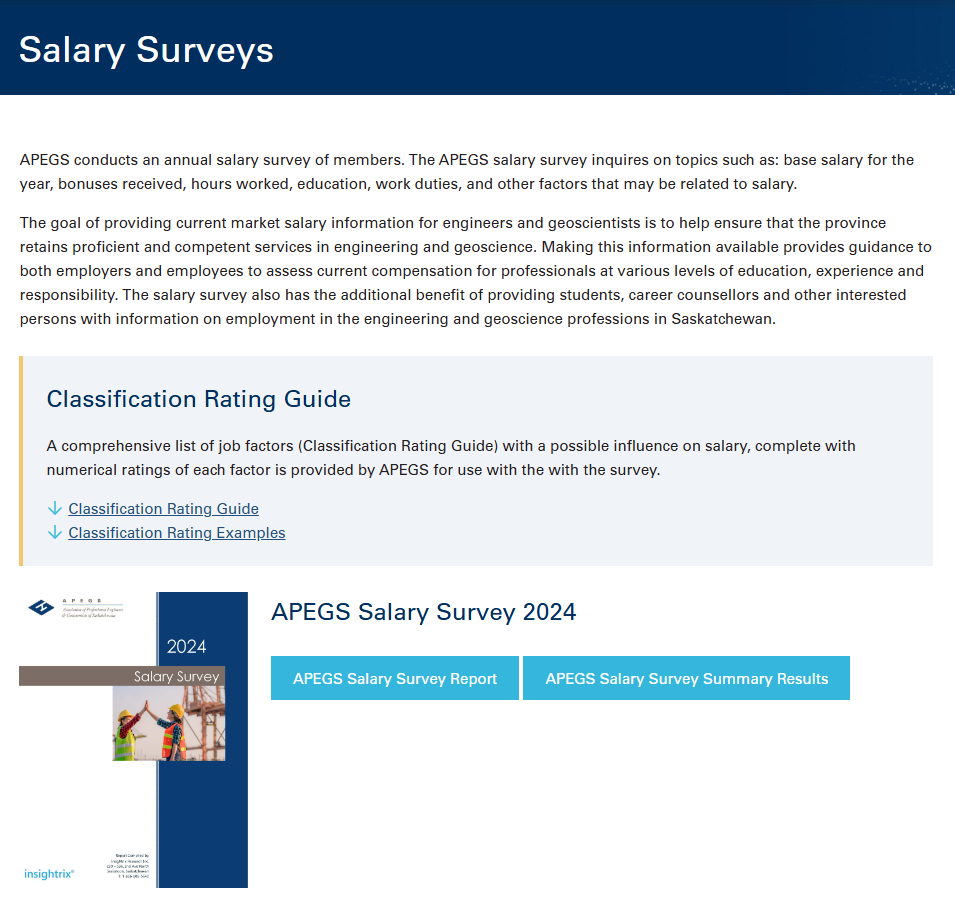For engineers in Canada, achieving the P.Eng. (Professional Engineer) designation is a pivotal career milestone that opens doors to increased responsibilities, professional independence, and higher earning potential. Yet, understanding what salary to expect as a P.Eng. across provinces can be challenging, given the regional differences and evolving industry trends. The 2023 APEGS Salary Survey sheds light on these salary expectations, offering up-to-date data on average and median salaries for engineers and geoscientists in Saskatchewan and providing valuable benchmarks for those in British Columbia, Ontario, and beyond.
In this guide, we’ll dive into key findings from the APEGS report, comparing P.Eng. salaries in Saskatchewan (P.Eng. Salary SK) to trends in British Columbia (P.Eng. Salary BC) and Ontario (P.Eng. Salary PEO). We’ll also explore the salary progression from engineers-in-training (EITs) to licensed professionals and discuss the factors that impact earning potential, including job role, industry, and professional designation.
Whether you’re an engineering student, an EIT preparing for licensure, or an established professional, this post will give you a clearer picture of the financial rewards that come with earning your P.Eng. in Canada and provide insights on how to navigate and maximize your earning potential in the engineering field.

What is a P.Eng. and How It Impacts Salary?
Becoming a Professional Engineer (P.Eng.) is one of the most significant career steps an engineer in Canada can take. This designation, awarded by provincial engineering regulatory bodies like APEGS in Saskatchewan, PEO in Ontario, and EGBC in British Columbia, allows engineers to take on legally binding responsibilities and perform regulated engineering tasks independently. This enhanced level of accountability and expertise translates to increased salary prospects, as shown in the 2023 APEGS Salary Survey, which highlights the financial benefits of holding a P.Eng. versus an Engineer-in-Training (EIT) designation.
Understanding the P.Eng. Designation
The P.Eng. designation is granted only after an engineer meets rigorous standards of education, work experience, and professional examination. For instance, engineers must pass the NPPE (National Professional Practice Examination) and complete several years of supervised practice. This process ensures that licensed engineers have the knowledge, skills, and ethical grounding needed to take full responsibility for engineering projects. As such, licensed engineers (P.Eng.) can sign off on designs, oversee significant projects, and are trusted to ensure the safety, functionality, and reliability of engineering work.
Salary Differences: Licensed Engineers vs. Engineers-in-Training (EIT)
The financial difference between a P.Eng. and an EIT is significant, as highlighted by the latest APEGS survey data. The survey reports that P.Eng. professionals in Saskatchewan earn an average of $129,651, with a median salary of $122,000, whereas Engineers-in-Training earn an average of $78,704, with a median of $74,880. This gap underscores the value that professional licensure adds to an engineer’s credentials and reflects the greater project ownership and liability taken on by P.Eng. professionals.
The earning potential for P.Eng. engineers is also evident in British Columbia and Ontario. While specific salary figures may vary by province due to cost-of-living differences and industry demands (P.Eng. Salary BC, P.Eng. Salary PEO), the trend remains clear: licensed engineers earn significantly more than their in-training counterparts. This disparity highlights the financial advantage of attaining a P.Eng., making it a worthwhile investment for engineers looking to increase their career growth and earning potential.
Geoscience Salaries – Licensed Geoscientists (P.Geo.) vs. Geoscientists-in-Training (GIT)
For geoscience professionals in Canada, achieving the P.Geo. (Professional Geoscientist) designation marks a significant milestone, granting the ability to practice independently, take on greater responsibilities, and often command higher salaries. The 2023 APEGS Salary Survey provides valuable insights into the financial rewards associated with becoming a licensed geoscientist compared to working as a Geoscientist-in-Training (GIT). Here, we explore these differences in depth, drawing on survey data to provide a comprehensive view of the salary progression in geoscience.
Average and Median Salaries: P.Geo. vs. GIT
The APEGS 2023 Salary Survey highlights the considerable salary increase associated with the P.Geo. designation. Licensed geoscientists (P.Geo.) in Saskatchewan earn an average salary of $131,974, with a median salary of $122,500. In comparison, Geoscientists-in-Training (GIT) earn a significantly lower average salary of $83,069, with a median of $85,000. This stark difference underscores the financial value of licensure, which allows professionals to take on higher levels of responsibility and work on complex projects independently.
The salary range further reflects this progression. For licensed P.Geo. professionals, the 5th to 95th percentile salary range in Saskatchewan spans from $85,000 to $190,000, compared to $55,575 to $108,000 for GITs. This wide range demonstrates the influence of experience, industry, and job role on earning potential, with licensed geoscientists often taking on roles with significant oversight, project management, or specialized expertise.
Increased Responsibilities and Autonomy with the P.Geo. Designation
The P.Geo. designation is more than just a title; it represents a professional’s readiness to take legal responsibility for their work, ensuring safety, accuracy, and adherence to regulatory standards. This level of accountability allows licensed geoscientists to independently approve and sign off on geoscience projects, such as resource exploration, environmental assessments, and geological surveys. Licensed professionals are often involved in project management, technical leadership, and strategic decision-making, which justifies the higher salaries reported.
In contrast, Geoscientists-in-Training (GITs) work under the supervision of a P.Geo., assisting in tasks such as data collection, analysis, and preliminary reporting. GITs are restricted in their autonomy and must rely on licensed professionals to validate their work, limiting their project control. The progression from GIT to P.Geo. thus represents not only a salary increase but also a transition to a more independent, impactful role within the field.
Industry Variations for Geoscientists: Resource Sector vs. Environmental Geoscience
Licensed geoscientists, particularly those working in high-demand sectors such as mining, petroleum, and resource extraction, often see salaries at the higher end of the range. For instance, professionals in resource exploration roles typically command competitive compensation due to the technical expertise required and the sector’s economic significance in Canada.
Environmental geoscientists, while also well-compensated, may experience a slightly lower salary range, though this varies widely based on employer, location, and project scope. Nonetheless, both sectors reward licensed professionals with salaries that reflect the importance of geoscience expertise in resource management, environmental protection, and sustainable development.
The Financial Incentives of Achieving P.Geo. Status
The substantial difference in salary between GITs and P.Geo. professionals, as highlighted in the APEGS survey, illustrates the financial and career incentives of pursuing licensure in geoscience. Not only does a P.Geo. designation increase earning potential, but it also expands career opportunities, as licensed geoscientists are eligible for roles with greater influence, responsibility, and potential for advancement.
In summary, the APEGS 2023 Salary Survey underscores the value of the P.Geo. designation for geoscientists in Saskatchewan and across Canada. With average salaries nearly 60% higher than those of GITs, licensed geoscientists benefit from both the financial rewards and the professional autonomy that come with full licensure. For aspiring geoscience professionals, achieving the P.Geo. designation is a key step toward career growth, greater responsibility, and enhanced earning potential in this vital field.
The Path to Professional Licensure
To progress from EIT to P.Eng., engineers must navigate a series of requirements, including supervised work experience under a licensed engineer, ongoing professional development, and passing the NPPE. This journey not only enhances technical skills but also provides practical, real-world insights into engineering project management and ethical responsibilities. By the time engineers achieve the P.Eng. designation, they are equipped to handle complex, high-stakes engineering work, which is reflected in the increased salaries they command.
In summary, earning the P.Eng. designation is more than a career milestone—it’s a gateway to greater professional autonomy, project leadership, and financial rewards. The APEGS 2023 Salary Survey data reveals the clear financial incentives for achieving licensure, positioning it as a compelling goal for engineers seeking both career advancement and salary growth.
Achieving your P.Eng. or P.Geo. designation is not just a professional milestone—it’s a powerful step toward greater career opportunities, higher earning potential, and a stronger impact in your field. The 2023 APEGS Salary Survey highlights how the financial rewards and career advancements that come with licensure are well worth the journey from EIT or GIT to full professional status. Whether you’re drawn to engineering, geoscience, or both, securing your professional license can unlock opportunities that make a real difference in your career.
If you’re aiming for your P.Eng. or P.Geo. and looking for guidance on how to navigate the requirements, prepare for exams, or advance your career, our team is here to help. Visit our Contact Page to connect with us and learn more about how we can support you on your path to professional licensure. Your journey to becoming a licensed professional starts here—let us help you reach your goals.


